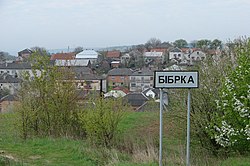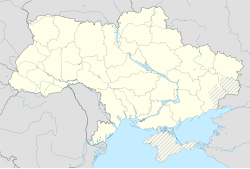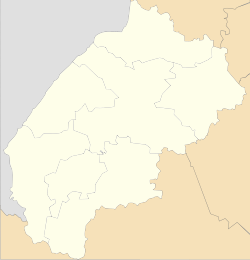Bibrka
Bibrka
Бі́брка Bóbrka | |
|---|---|
City | |
 Skyline of Bibrka | |
| Coordinates: 49°37′N 24°14′E / 49.617°N 24.233°E | |
| Country | |
| Oblast | |
| Raion | |
| Population (2022) | |
| • Total | 3,761 |
| Time zone | GMT+2 |
Bíbrka (Template:Lang-uk; Template:Lang-pl; Template:Lang-yi) is a city in western Ukraine, located in Lviv Raion of Lviv Oblast (region) about 29 km southeast of Lviv on H09. It hosts the administration of Bibrka urban hromada, one of the hromadas of Ukraine.[1] The population is approximately 3,761 (2022 estimate)[2].
The town has been ruled at various points by the Kingdom of Poland, Polish–Lithuanian Commonwealth, the Austrian Empire, the Kingdom of Galicia and Lodomeria, the Russian Empire, Poland, the Soviet Union, and is now part of the Lviv Oblast in Ukraine; as a result Bibrka has several official and native names, including: Bóbrka (Polish/Russian), Prachnik (German), and Boiberik/Boyberke (Yiddish). The city has a population of 3,980.
Bibrka was the site of a Soviet prison and detention centre that detained Poles and others in the mid-20th century.
History
This section needs expansion. You can help by adding to it. (May 2013) |
The first mention of the city dates back to the Galician-Volhynian Chronicle of 1211, as well as mentions of neighboring villages – Stara Biborka and Nova Biborka. The Biborka River is also mentioned, as well as the ancient tract of Boberka (Biborka), which means a place where beavers were hunted in ancient Rus. According to other sources, the year 1211 is not the year of the first mention of the city of Biborka, but of the river of the same name. As for the settlement itself, it began to be mentioned in chronicles only from 1436 as the possession of Vnuchek from Kutno. The settlement was owned by the Polish king and was part of the Grand Duchy of Lithuania. Local craftsmen – tanners, weavers, shoemakers, and merchants – paid taxes to the Lviv starosta as the king's representative. Biborka was often leased to feudal lords.
From the first partition of Poland in 1772 until 1918, the town was part of the Austrian monarchy (Austria side after the compromise of 1867), head of the BOBRKA district, one of the 78 Bezirkshauptmannschaften in Austrian Galicia province (Crown land) in 1900.[3] The fate of this province was then disputed between Poland and Russia, until the Peace of Riga in 1921. In the middle of 1941, approximately 2,000 Jews lived in Birbrka. The Germans commenced their occupation of the town during World War II on June 30, 1941. In 1942, the Germans created a ghetto for the remaining 1,500 - 1,900 Jews who had not been deported to the Bełzec extermination camp. Approximately 300 Jews died in the ghetto due to disease and illness. The ghetto was liquidated on April 13, 1943, during which over 1,300 Jews were killed on a site in the nearby village of Volove.[4]
The region was annexed by the Soviet Union in 1945.
Until 18 July 2020, Bibrka belonged to Peremyshliany Raion. The raion was abolished in July 2020 as part of the administrative reform of Ukraine, which reduced the number of raions of Lviv Oblast to seven. The area of Peremyshliany Raion was merged into Lviv Raion.[5][6]
Gallery
-
Epiphany Church in Bibrka
-
St. Nicholas Church
-
A street in Bibrka
-
City park
References
- ^ "Бибрская громада" (in Russian). Портал об'єднаних громад України.
- ^ Чисельність наявного населення України на 1 січня 2022 [Number of Present Population of Ukraine, as of January 1, 2022] (PDF) (in Ukrainian and English). Kyiv: State Statistics Service of Ukraine. Archived (PDF) from the original on 4 July 2022.
- ^ Die postalischen Abstempelungen auf den österreichischen Postwertzeichen-Ausgaben 1867, 1883 und 1890, Wilhelm KLEIN, 1967
- ^ "Yahad-In Unum Interactive Map". Extermination Sites of Jewish Victims Investigated by Yahad-In Unum. Retrieved 20 January 2015.
- ^ "Про утворення та ліквідацію районів. Постанова Верховної Ради України № 807-ІХ". Голос України (in Ukrainian). 2020-07-18. Retrieved 2020-10-03.
- ^ "Нові райони: карти + склад" (in Ukrainian). Міністерство розвитку громад та територій України.
External links
- (in Polish) Bóbrka (Bibrka) in the Geographical Dictionary of the Kingdom of Poland (1880)
- JewishGen ShtetLinks, Bóbrka by Bev Shulster. Retrieved 25 May 2006
- My Bibrka (in Ukrainian)
- Bobrka, Ukraine at JewishGen








